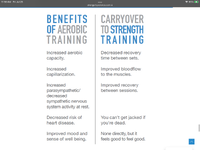If you interpreted from my post that one somehow magically generates 2.2 million pounds of force instantaneously, you need to learn how to read better.
In your original post you stated, "
As you can see total force absorbed by my body is roughly 2.2-2.7 million lbs when doing a 60 min slow jog. "
Your implication is that you are accumulating 2.2-2.7 million pounds of volume. I didn't say its "instant", I stated that submaximal efforts don't accumulate stress in a "reservoir" of volume in the way you are presenting.
ALL TRAINING comes down to managing three variables: intensity, volume, and frequency. They all need to be in balance based on individual capacity and recovery.
This is absolutely correct, however, in your original post, you seemed to be conflating volume and intensity at will when you compared your 2.2 million pounds of force from running with "20-25k lbs of weight moved" during a strength session, implying that the stress on the body was much greater while taking a zone 2 jog (Obviously terrain, gradient, altitude etc could produce vastly different experience of stress while running). You disregarded intensity all together with this comparison. From this comparison, one could extrapolate that a 450 lbs squatter could receive sufficient training stress by squatting 45 lbs for 10 reps.
What I was referencing was total VOLUME in a given workout. If I lift 100lbs, 10 times that is 1000lb of total work done in that lift. Even if your foot momentarily strikes the ground Newton's 3rd law is still in full effect. You have an eccentric and conetric muscle contraction with each foot strike...e.g. you are doing work with each foot fall.
This is why presenting pure volume in pounds/kilos as a stand alone metric is misleading and often presented in a disingenuous manner. You can look at total weight moved as one metric, but viewing it without context of intensity is a mistake. Again, a 450# squatter squatting a 45# bar for 10 reps is technically 450# lbs of volume, but contextualized, its such a submaximal effort that it accumulates no meanningfull training stress. As a 405# squatter, you could probably do a single 45 lbs rep every 5 minutes for 24 hours straight, squatting a total of 12,960 lbs without producing any meaningful training stress (other than being tired from being up for 24 hours). You can say, "I squatted 12,000 of volume", but what does that really mean once it is contextualized? For you, as a strong, 405# squatter, it would mean very little. I suppose you could brag about it on the David Goggins podcast.
When you say, {paraphrased] "Listen, ya'll, I'm the ultimate baddass and my zone 2 jogs produce up to 2.7 million pounds of stress where my lifting, despite me being strong, only produces 25,000 lbs of stress by comparison, therefore jogging is the greater stressor", that is exactly what you are doing.
Quote:
"As you can see total force absorbed by my body is roughly 2.2-2.7 million lbs when doing a 60 min slow jog. That is an insane volume. Rucking is about half that. Slow jogging hardens my connective tissues like nothing else and also produces iron lungs and heart.
Compare that to my barbell workouts where I average 20-25k lbs of weight moved."
A more accurate display of the training effect of your running is that your body can handle Jogging (225 lbs)<br>Cadence: 165 SPM<br>GRF: 2.0–2.5× BW repeatedly for X amount of duration. Fact of the matter is, Jogging (225 lbs)<br>Cadence: 165 SPM<br>GRF: 2.0–2.5× BW is an extremely submaximal effort for you, which is why you can do it over and over again for 60 minutes or more at a time, just the same as why you could theoretically squat 45# every 5 minutes for 24 hours in the previous example. Mountain athletes focus on Zone 2 so heavily because it is a pace that can be maintained for hours on end. Now, at some point, CNS fatigue becomes a factor and you could potentially discover that fatigue benchmark by measuring total force the body absorbed, but that is not what the argument you have presented.
It is impressive that you can handle all of that conditioning and still squat 405#. That's a difficult marriage.
Nonetheless, the way you have presented running volume as metric is disingenuous and, as an argument, you are freely moving between the volume and intensity as metrics to satisfy your own conclusion. And, when questioned on it, you get radically defensive. Do what you will, I'm just pointing out the fallacy.
--
Again, I'm not invalidating zone 2 conditioning and the importance of it in any way, I'm arguing with the way you are presenting the stress effects of it in relation to volume as a metric.
www.strongerbyscience.com

